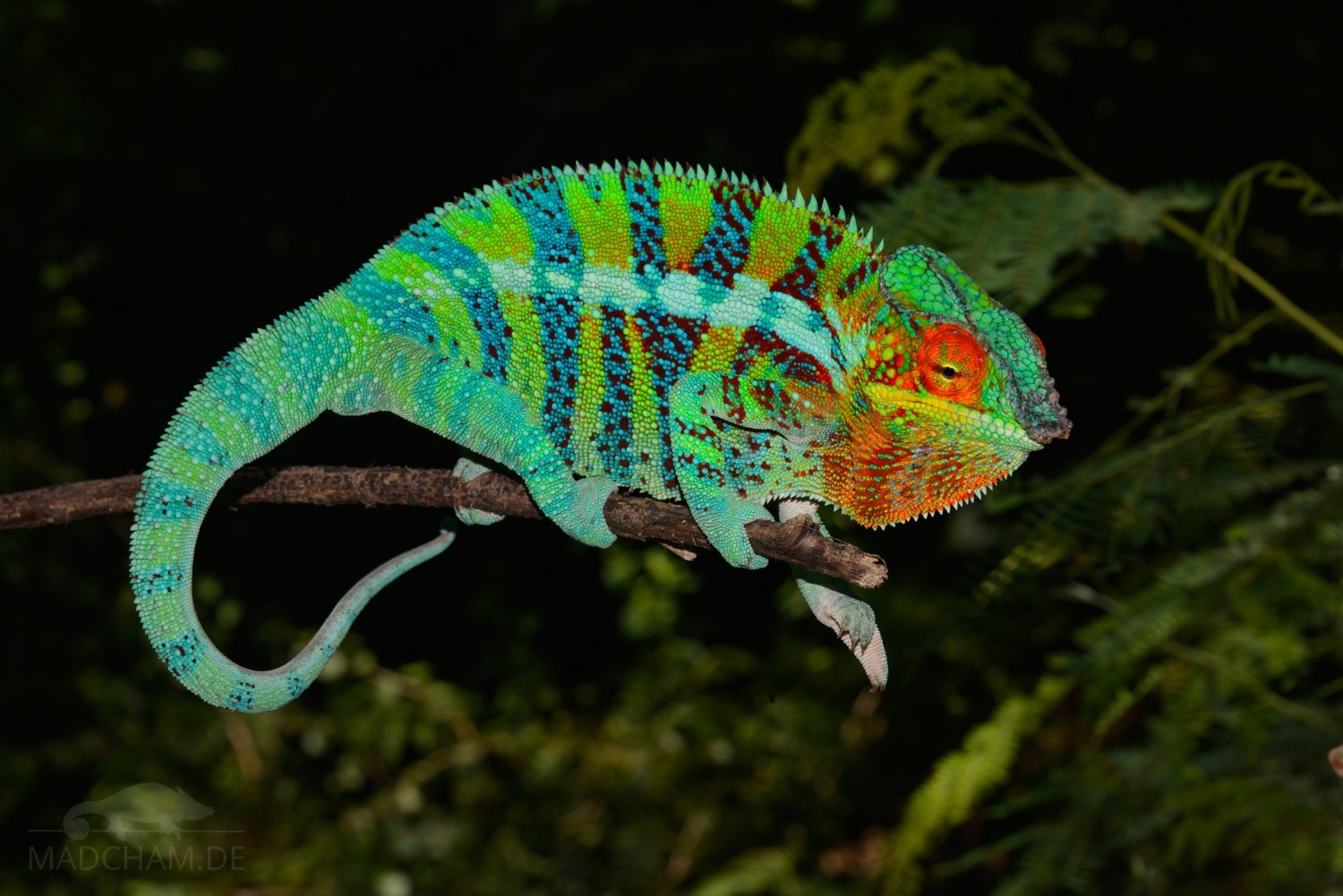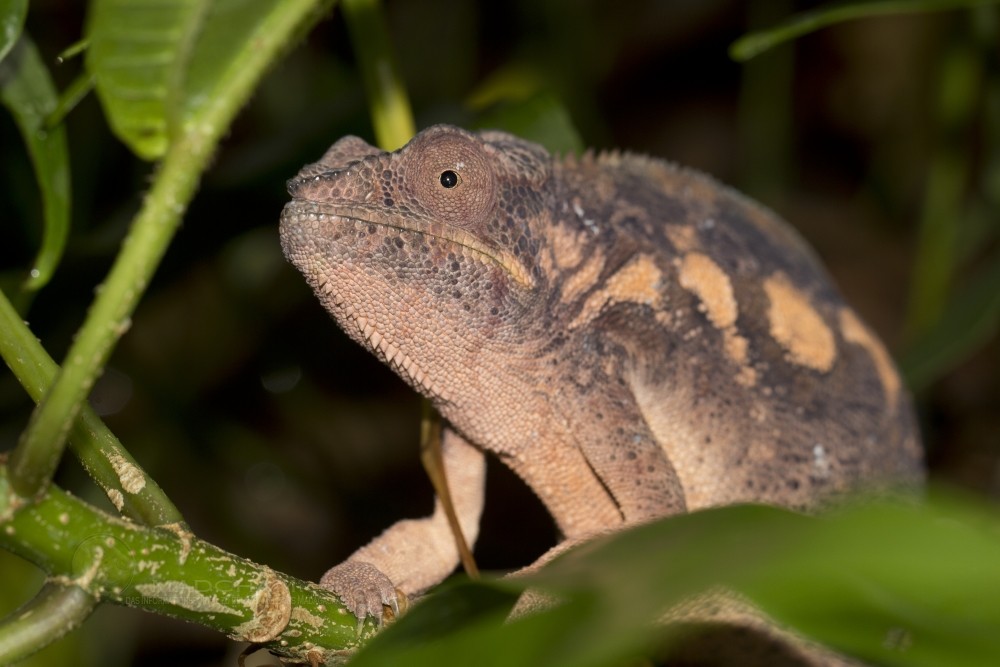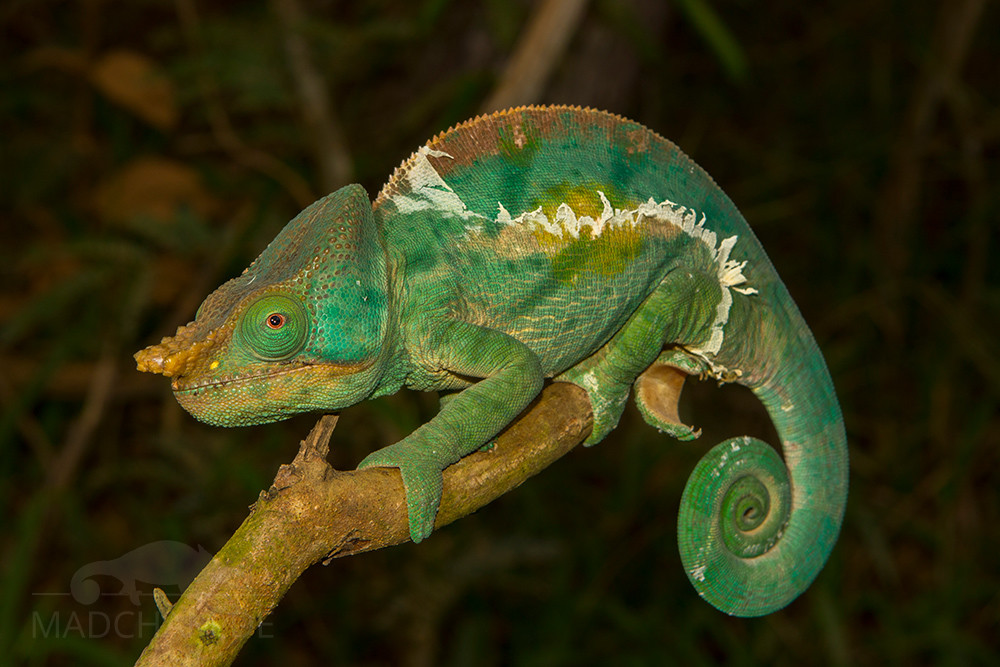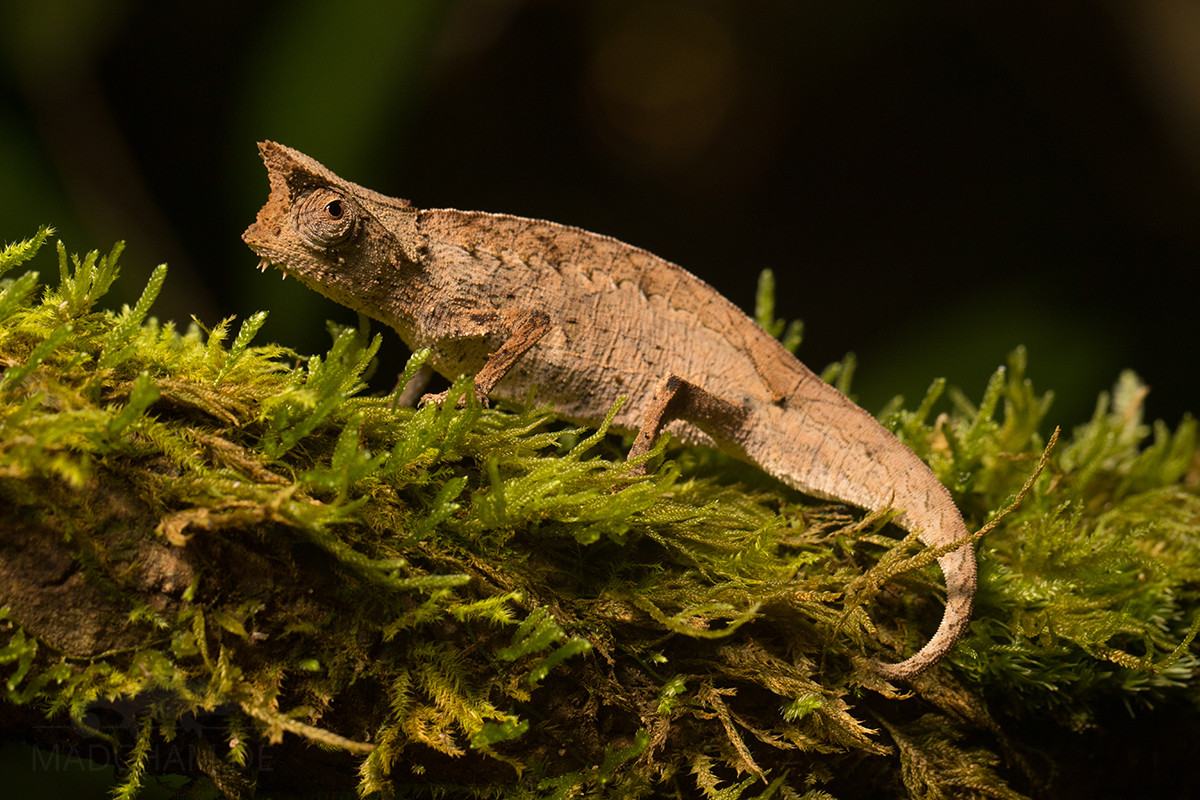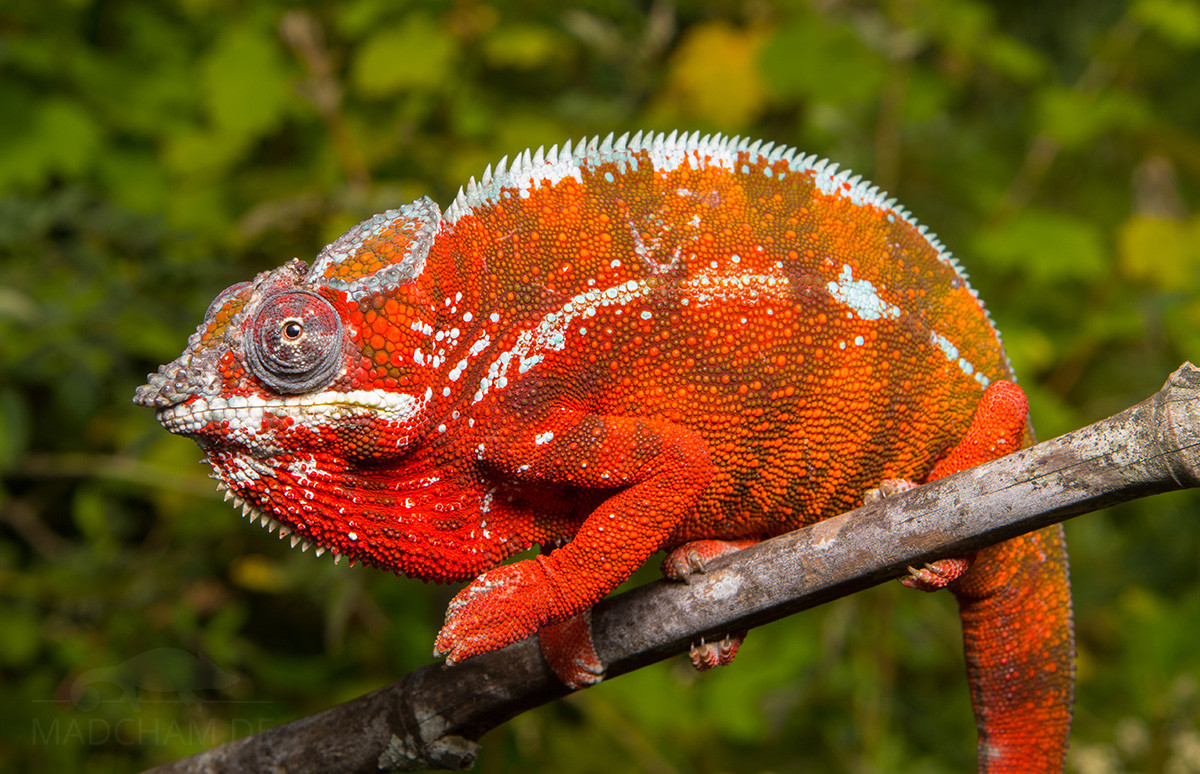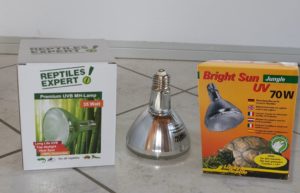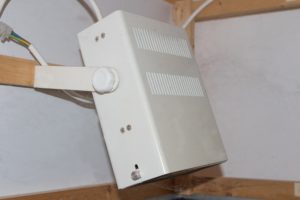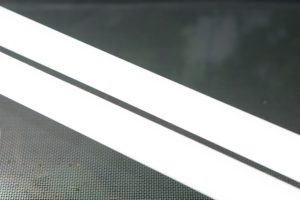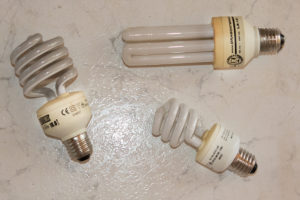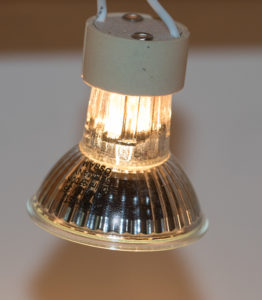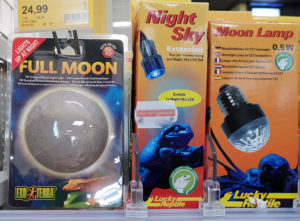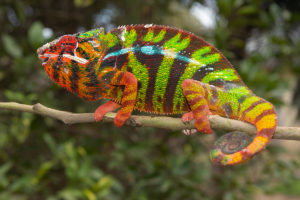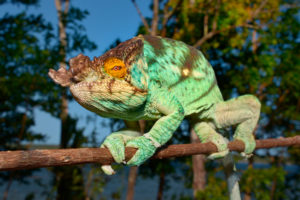Naturally, lighting belongs naturally to the species-appropriate terrarium. The lighting is secured by different lamps. In the last decades, a lot has happened in this area so that the imitation of nature-like lighting conditions becomes increasingly easier. This article is intended to give a rough overview of the different possibilities of illuminating a chameleon terrarium.
Inhaltsverzeichnis
Basic information on lighting
Before putting together a lighting setup, you have to consider what goals you want to achieve with the lamps you use. Chameleon terrariums are mainly about creating sufficient brightness to make the animal feel comfortable and to imitate the natural habitat as well as possible. A second, just as the important purpose is the warming up of the chameleon, as its metabolism can otherwise not function properly, as in all ectothermic animals. And a third, equally important point is the supply of vital UV-B radiation in order to produce vitamin D. A separate article is dedicated to UV-B radiation only. In addition, the light should suffice for the plants in the terrarium to grow. It would also be good if the light used comes close to the colour vision of the chameleon, because – unlike us humans – it also sees in the UV-A range. Therefore, for example, the colour temperature (Kelvin) and the colour rendering value (Ra) are completely unsuitable for assessing the suitability of a lamp for chameleon terrariums. They are based on human vision. But what we as humans feel as bright and beautiful, doesn’t have to be the same for a chameleon.
If a rough overview is not enough for you, we recommend the last section of this article with further reading.
Attention: The placing on the market of UV metal vapour lamps, mercury vapour lamps, UV fluorescent tubes and UV compact fluorescent tubes will be banned in the EU from February 2027. There are currently no exceptions for herpetoculture. The sale of remaining stocks is permitted, but these will be used up very quickly. Similar legislation is also planned for other countries, for example in the USA.
Metal halide lamps
These lamps are known in terraristics under the abbreviation HQI (Osram calls them so). They require a ballast and function as gas discharge lamps in which metal atoms are excited by electrons and emit energy in the form of light. HQIs are inexpensive to operate and achieve a high brightness of up to 100,000 lux, which is even similar to nature (a sunny day has about the same lux number). They are therefore well suited for the basic illumination of chameleon terrariums.
For more than ten years there have been HQIs, which also emit UV-B and thus, of course, become even more interesting, as they cover all areas required for a chameleon: Brightness, heat, and UV-B radiation. These lamps include the Bright Sun from Lucky Reptile, the Solar Raptor from Econlux, and the MD lamps from Reptiles Expert, all of them often used by chameleon keepers. Which UV index for which chameleon species Madagascar should be available at most can be read from the daily profiles of the different regions in the species and habitat data section. A simplified representation of the correct UV index for Madagascan chameleon species is offered by the modified Ferguson zones proposed by us here.
Of course, there is no lamp that would not also have disadvantages. In metal vapour lamps with a UV-B component, the radiation is often so strongly concentrated that it can cause burns in the central beam of the lamp. Lamps are better when the radiation is less concentrated, but rather distributed more evenly (usually as a “flood” variant in the trade). For domestic use: If the lamp is held over a white sheet of paper, the light cone should be evenly distributed and not have an extremely bright spot in the middle.
UV metal halide lamps must always be suspended at a safe distance and measured exactly with the solarmeter 6.5. You can find more information about this topic in this article. In addition, they have a shorter service life than conventional HQIs (the latter often lasted for years). Also important: HQIs must always cool down for a good ten minutes after they have been switched off. During this time they cannot re-ignite, so they will not start even if power is restored. Likewise, HQIs need a few minutes to “burn up”, i.e. to unfold their full function.
Mercury vapour lamps
Mercury vapour lamps (called HQL at Osram) are high-pressure discharge lamps in which a gas discharge with light development occurs when a voltage is applied. Mercury vapour lamps always require a ballast. HQL used to be used a lot in the keeping of chameleons but was increasingly replaced by the development of UV metal vapour lamps and mixed light lamps. They emit relatively little visible light but provide a good UV-A component in the light in the terrarium.
Mixed-light lamps
Mixed-light lamps (Osram calls them HWL) are, as the name suggests, a mixture of two lamps: the incandescent lamp and the high-pressure mercury vapour lamp. They emit bright light, UV-A, and heat at the same time. Disadvantages of mixed light lamps are the relatively high power consumption in comparison to the emitted light, the uneven spectrum, and constant flickering. The latter is very likely well visible to chameleons with their highly developed eyes. If you are looking for a lamp to burn all day long over the terrarium, metal halide lamps and fluorescent tubes are more efficient than mixed-light lamps.
In the case of UV mixed-light lamps, which are increasingly available on the market, there is still the problem that even within a single batch there are strong fluctuations in UV-B radiation. While some lamps do not emit UV-B at all right from the start, others emit sufficient UV-B, and others emit far too much. If you want to ensure sufficient UV-B radiation from your chameleon, you cannot avoid purchasing a 6.5 Solarmeter and measuring the lamps monthly. This page provides a more detailed overview of the various UV mixed-light lamps on the market.
Special mixed-light lamps: Osram Ultra Vitalux
Osram has been producing a very special mixed light lamp for decades, whose glass is transparent to UV and can, therefore, be used to supply UV-B to chameleons: The Osram Ultra Vitalux 300W. This lamp still plays an important role in the UV-B irradiation of chameleons today, so it occupies a separate area in the corresponding article here.
Fluorescent bulbs
Together with metal halide lamps, fluorescent lamps are among the most efficient ways of illuminating terrariums. They illuminate the chameleon terrarium flat and evenly, but cannot concentrate the light with a reflector. The light does not reach very far into the depth, so fluorescent tubes are a good choice mainly as basic lighting, especially for terrariums that are not particularly high. Fluorescent tubes can, therefore, be used as lighting for ground-living chameleons like Brookesia and Palleon.
The most common fluorescent lamps used in chameleon keeping are T5 and T8 tubes. They require a ballast and differ in diameter, service life, and some technical details. The luminous efficacy of a T8 tube with ECG is similar to a T5 tube with ECG. However, the T5HE (HE stands for high efficiency) available today is much more efficient, so switching from T8 to the newer T5HE can reduce your electricity costs. In the meantime, there are also fluorescent tubes that contain a certain amount of UVB, e.g. from Arcadia.
Compact lamps
Compact lamps belong to the fluorescent lamps, they are quasi “coiled” fluorescent tubes. Due to this modified shape, the light is more focused and achieves higher irradiances in the UVB range than the same models in tube form. However, the gradient of the UV index in compact lamps is very sharp. This means that a very high (too high) UV index is often achieved at a short distance from the lamp, while a very low (too low) UV index remains only a little further away. In addition, the UV index and thus the UVB radiation usable by chameleons varies massively between the different compact lamps. How to measure the UV index of UV-B radiation, which is important for chameleons, you can read here.
The emitted light and also UVA radiation is minimal in compact lamps, so they emit a very unnatural light overall. Sun-like light would combine strong brightness with UVA and UVB radiation. Around 2007, there were numerous cases of compact lamps from various manufacturers emitting UVB radiation that was too short wavelength, causing eye disease in chameleons and other reptiles. The problem seems to have been largely eliminated by major manufacturers today.
We still advise against the use of compact lamps for chameleons due to all the disadvantages mentioned above.
Incandescent lamps
In incandescent lamps, light is produced by incinerating a metal wire and then emitting light and heat. They mainly produce heat and only little light, but no UV radiation that can be used for the chameleon. They can, therefore, be used as an additive for chameleon terrariums if metal vapour lamps or mixed light lamps do not reach the desired heat in the sunny spot. Halogen spots are mostly used for this purpose. In particularly damp terrariums, halogen spotlights can also be used outdoors.
Light-emitting diodes (LED)
The trend in living rooms has been towards LED for years, a light-emitting semiconductor device. LEDs have a great advantage that they produce visible light for people with extremely low energy consumption and without heat generation. Here, however, the disadvantage for chameleons also comes directly to bear: LEDs do not cover the visual spectrum of reptiles. They always have a strong turquoise effect on reptiles. What we humans perceive as bright and great unfortunately arrives quite differently with chameleons because of the other vision. Attempts to assemble individual LEDs as close together as possible to form a “mixed-light” unfortunately do not resemble the light spectrum of the sun and it remains questionable whether the light distribution is even at all or whether “coloured shadows” are created everywhere for the chameleon. Chameleons additionally need heat sources, as they are ectothermic. LEDs could therefore only be used in combination with other lamps.
Overall, the cost-benefit ratio for light in chameleon terrariums is currently much better served by metal vapour lamps. CAUTION: In recent years, more and more LEDs that are supposed to emit additional UV-B have been entering the market. Tests so far show that these UV-B LEDs emit extremely short-wave UV-B radiation, in some cases even UV-C. This makes them dangerous for chameleons. This makes them dangerous for chameleons; we can only strongly advise against their use.
Attaching the lamps
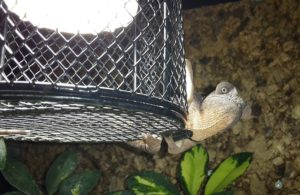
That’s not how it’s supposed to look like: A female panther chameleon climbs a lamp protection cage. It would be better if the lamps were mounted above the terrarium.
With chameleons, it is extremely important to install all lamps outside the terrarium. Most holders build a lightbox, i.e. a frame above the terrarium, which is open towards the top and to which the lamps are attached. Chameleons are climbing artists and at some point, they reach the most impossible places. Protective bulb cages, as offered for other reptiles in the pet trade, are unfortunately unsuitable for chameleons. In most cases they can still reach the lamps – not least with their shooting tongues – or at least get close enough and burn themselves sensitively. Unfortunately, burns are still one of the most common diseases in chameleons kept in terrariums.
The terrarium for a chameleon should always have a gauze lid so that sufficient light can penetrate. Perforated sheeting or similar takes too much light and is not suitable for chameleon terrariums.
Day length
In Madagascar, there is no extreme change in day length over the year. On the island, there are around 11 hours of sunshine and 13 hours of darkness throughout the year, with deviations of a maximum of two hours during the course of the year. In Europe, on the other hand, the daylight varies enormously over the year with over 16 hours of brightness in summer and less than eight hours of daylight in winter (depending on the country). There are now two ways to deal with this discrepancy.
Either one ignores the seasonal differences and stubbornly drives the 11-13 light scheme to imitate Malagasy conditions. This means, however, that the lamps above the terrarium already switch off in summer when it is still light outside. In all rooms with windows, chameleons notice that it is still light and usually remain active until dusk. On the other hand, the light still runs over the terrarium in winter, while it is already pitch-black outside. It can happen that the chameleon has already gone to a sleeping position long ago, although the terrarium light still shines.
The more common variant for many keepers is to adjust the day lengths of the chameleons held in Europe to the outside hours of sunshine, i.e. to leave the light on longer in summer and to shorten it in winter. With this light regime, many chameleons become more inactive, paler, and eat less in winter. As soon as the days get longer again, they return to their usual activity and colour.
Imitation of sunrise and sunset
If you hold your chameleons in windowless or relatively dark rooms, you can slowly switch the lamps on and off one after the other to simulate the sunrise and sunset. In rooms with windows, the animals usually depend on the ambient light anyway. It has often proved successful to switch on fluorescent tubes first and then gradually switch on the heat and UV-B lamps. Fluorescent tubes can also be dimmed to make the transition as sunlike as possible. Dusk of up to 50 minutes, as we are used to in Germany and central Europe, does not exist in Madagascar, by the way. The sun disappears within about 15 minutes and reappears just as quickly in the morning.
Night and Moon Lights
In the zoo trade and on the Internet, so-called “moonlight” is offered in many places, which one switches on at night over the terrarium and which shall imitate the light of the moon. In most cases, these are blue LEDs, but they do not imitate real moonlight. They are much too bright compared to natural moonlight. The blue light actually belongs to the daytime spectrum, which can disturb the day-night rhythm of chameleons via the pineal gland.
And finally
If you want to get into the topic of light in the terrarium more intensively, the website of the same name by the physicist Sarina Wunderlich is very well served. Her website contains detailed explanations of all lamp variants, frequently asked questions in terraristics, differences between CCGs and ECGs, tips for measuring lamps, differences between frosted and clear glass bulbs, and everything else concerning the topic of light in the terrarium. A big thank you to Sarina for allowing us to link her page.

